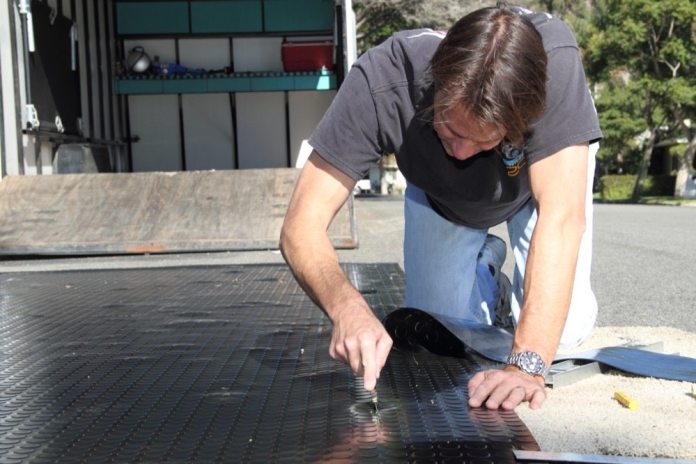See if you have heard this one before. A guy gets involved deeply enough in HPDE that he buys an open trailer to tote his track car back and forth to the events. Then as soon as he gets a competition license, he turns his sights toward an enclosed trailer. Knowing that’s what would happen to me, I skipped an open trailer, because I knew that as soon as I got one, I’d want an enclosed. Trouble was, my budget was limited, so that meant searching for a decent used trailer. It took a few months of scouring, but I finally found one that would work.
For just a bit more than a new, open trailer, I bought an 8-foot by 20-foot enclosed trailer with built-in cabinets and a countertop with drawers. Trouble was, it was used for a long time to haul ATVs back and forth to the desert. Evidently, the previous owner’s ATVS all leaked oil, so the bare plywood floor was a spotted mess. I probably could have painted it, but that would have meant sanding and priming and painting, and of all the tasks in the automotive world, I probably hate sanding the most. Painting is the not-so-distant second. Even after I had painted the floor, I likely would not have been happy with it, so that meant finding another solution. I could have used linoleum tile, but it might not have adhered to the oily wood.
There were other options, such as garage tiles and mats or recycled rubber gym tiles, but they either cost more than I wanted to spend — more than $500 — added a couple of hundred pounds of weight or wouldn’t stand up to petroleum products being spilled on them. Then a buddy pointed me to the Home Depot website, which offered an 8-foot by 22-foot roll of coin-mat flooring for $341 plus freight. It weighed about 125 pounds, which was doable and it was thick enough that it wouldn’t require glue to hold it down. Home Depot also offers a 10-foot by 24-foot roll for $465, which is ideal for car trailers that measure 8-feet 6-inches wide.
Installation was pretty straightforward. Measure everything twice so you can cut once. Draw out the floor plan and fill in the dimensions. Get a buddy to help you if you can. I could have just laid down the mat and called it good, but I bought some 1-inch aluminum strips to retain the edges and make for a more finished look. Now I have a trailer that is much nicer inside, which is good because it also is my hotel during race weekends. With a bit of luck, the mat might keep it warmer inside, too.
Required Tools
- Leaf blower
- Socket Set
- Box wrenches
- Utility knife
- Drill
- Tape measure
- Metal straight edge
- Combination square
- Industrial crayon
- Scrap carpeting
- Die grinder
- Legal pad and pen
- Rust-Oleum marine-grade deck paint
- Nonskid tape
Recommended Tools
- Knee pads
Be sure you lay the matting out in the sun to soften it up before laying it in the trailer. As you will see in the video, the rubber retains a lot of static, so every little bit of debris sticks to it. Dust it off as you roll it up so the matting won’t have any bumps under it when it’s installed.
Required









































